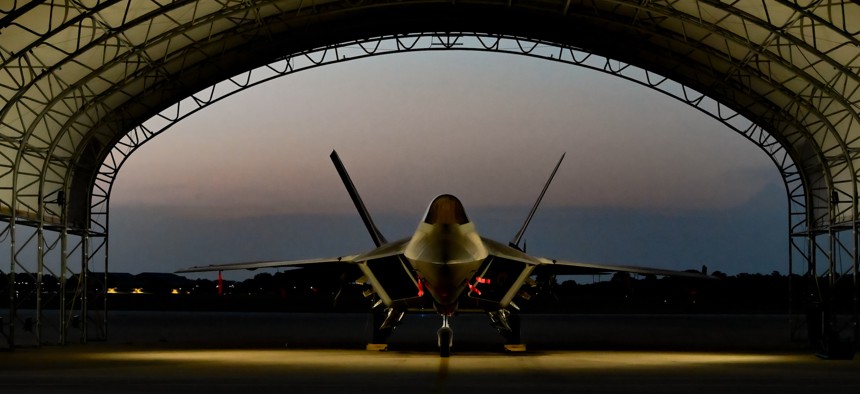
F-22 Raptors assigned to the 94th Fighter squadron United States Air Force 1st Operations Group, sit on the flight line at Joint Base Langley-Eustis, Virginia, Sept. 3, 2020. Staff Sgt. Ericha Fitzgerald | U.S. Air Force
The Air Force Is Planning For a Future Without the F-22
Just four fighters will make up the future fleet: F-35, F-16, F-15EX, and NGAD, chief says.
The U.S. Air Force aims to pare its fighter fleet to just four types — and the F-22 Raptor won’t be among them, the service’s top general said Wednesday.
Those four will be the F-35, F-15EX, F-16, and the Next Generation Air Dominance, or NGAD, fighter, Gen. CQ Brown, Air Force chief of staff, said at a McAleese and Associates virtual conference.
“Right now we have seven fighter fleets,” Brown said. “My intent is to get down to about four, OK, and with that four, what is the right mix?”
Brown said the fighter makeup is “really a four-plus-one, because we're going to have the A-10 for a while as we re-wing” the venerable Warthog to extend its service life into the 2030s.
The F-22 will be replaced by the NGAD jet, which will fly alongside the “F-35, which will be the cornerstone, [the] F-15EX as we come in, and then we'll have F-16 for a while as well,” Brown said.
The Air Force currently has 186 F-22s, according to a Heritage Foundation count in November. They are just 12 years old on average, Heritage reported, making the type among the youngest in the fleet. But the F-22 has faced low mission capability rates, in part due to structural upgrades that often take multiple aircraft offline.
Last year, Air Force leaders hinted that they might buy the F-15EX not just to replace older F-15Cs but also the 218 newer F-15E Strike Eagles.
Brown said the Air Force is determining the right mix of fighters through an internal tactical air study that all of the services are participating in, to look “across the board, [at] all of our combat aircraft, our attack, our fighter portfolio.”
“I'm really looking for a window of options, because the facts and assumptions based on a threat will change over time,” he said. “But I want to get us shaped in a direction, because right now we have seven fighter fleets. Okay, my intent is to get down to about four.”
The study is not expected to shape the Air Force’s fiscal year 2022 budget request. “It’s really designed to help me build out ’23,” Brown said.
Brown said the service is still considering what will be the replacement for the F-16, “whether it's additional F-35, or something else into the future. But I don't need to make that decision today. That's probably six, seven, eight years away into the future,” he said.
One analyst cautioned against overestimating the potential savings of retiring jets.
“They never get the numbers they expect when they downsize to save money first,” said John “JV” Venable, a former F-16 pilot and a senior fellow at the Heritage Foundation's Center for National Defense. “The numbers of tactical airframes are already too small and the service can't afford to suffer another cost-saving move that results in it getting even smaller.”
“The F-35 was supposed to replace the F-16 and the A-10,” Venable noted. “How the service justifies acquiring a new combat-equipped 4th-gen platform” — the F-15EX — defies logic, he said.
The F-22, built to dominate Soviet warplanes in air-to-air dogfights, has never shot down an enemy plane in combat. Instead, the plane made its combat debut over Syria in 2014. Raptors have also deployed to the Middle East to deter Iran.
Decades ago, the Air Force envisioned a fleet of 750 Raptors, but the fleet was capped at just 187 jets. Contractor Lockheed Martin delivered the final F-22 to the Air Force in 2012.
Since then U.S. officials have occasionally pondered restarting production of the plane, but the efforts never materialized. At one point, Lockheed proposed building new F-22s with more modern electronics used in the F-35 stealth fighter. Ultimately, the Air Force chose to buy updated F-15 fighter jets from Boeing.
Various allies have expressed interest in buying the plane, but U.S. law prohibits its export.
Seventeen F-22s were damaged in 2018 when a hurricane destroyed Tyndall Air Force Base in Florida.